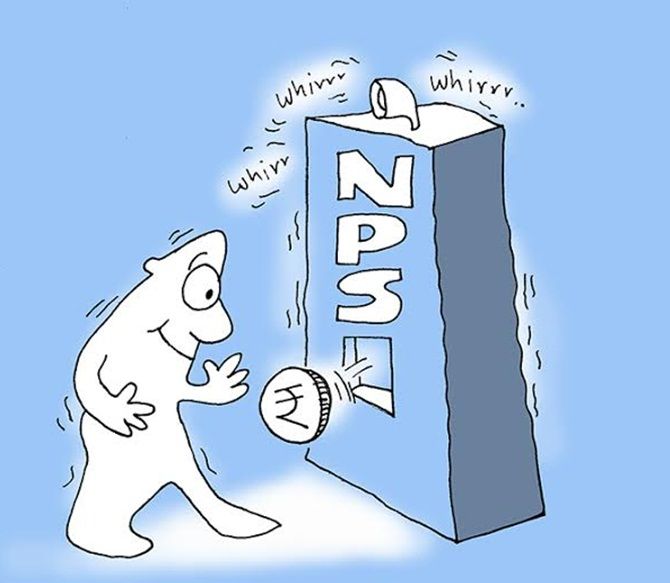Reduction in the mandatory minimum contribution and extension to invest in the scheme from 60 years to 70 years has made the National Pension Scheme more friendly, says Anil Chopra, Group CEO & Director Bajaj Capital
Illustration: Uttam Ghosh/Rediff.com

Retirement for most of us remains the most ignored goal. To make people save for their retirement, government has a pension-focused scheme in place, called the National Pension System (NPS), administered and regulated by Pension Fund Regulatory and Development Authority (PFRDA), created by an Act of Parliament.
National Pension System (NPS) has emerged as a very popular option amongst Indian taxpayers, particularly after April 1, 2015 as Section 80CCD(1)B was introduced in the last Budget to give additional tax break to subscribers.
NPS was launched by PFRDA in the year 2004 for Central and State government employees only and subsequently in the year 2009 the same was made open for general public also. However, the scheme was unable to attract the masses at that time.
Post Budget 2015 announcements, NPS has become much sought after investment option as a taxpayer can save additional tax of up to Rs 15,000 by opening an NPS account and investing Rs 50,000 in the scheme provided s/he is in 30 per cent tax bracket.
Once your section 80C limit is exhausted, make use of NPS to save additional tax.
There are 3 fund options to choose from: equity, debt and balanced.
You can also choose your own fund manager. There are PFRDA regulated professional fund managers who invest as per the approved investment guidelines into the diversified portfolios comprising of government bonds, bills, corporate debentures and shares.
If you aren't sure which asset to choose -- equity or debt, there's a default option.
Further, there's a lifestyle asset allocation option, wherein funds keep shifting from equity into debt. The plan ends at age 60, and you can withdraw up to 60 per cent of corpus. On the balance, there's compulsory pension from an insurer.
As per the new guideline, where subscriber desires to continue the contribution to NPS beyond the age of 60 years can now extend it till the age of 70 years.
Only prior intimation (15 days before the attainment of 60 years) to Central Record keeping Agency (CRA) is required.
On investing in NPS, you get a Permanent Retirement Account Number (PRAN) through the CRA, which captures all your data including personal details and transactions. The initial account that gets opened is the Tier I account of NPS.
Optionally, you may open Tier II account. You get an Internet password for online transactions too.
To boost wider coverage in NPS and aiming to increase the availability of NPS to all the segments of citizens, the Pension Fund Regulatory and Development Authority (PFRDA) has reduced the mandatory minimum contribution requirement of Rs 6000 to Rs 1000 in Tier I account.
It also decided to unfreeze all the existing frozen accounts due to non-contribution of minimum contribution in Tier I or Tier II accounts as a one-time measure with immediate effect.
Under previous guidelines, a subscriber had to contribute minimum Rs 6000 per financial year to keep the account active and in Tier II to at least contribution of Rs 250 and account balance of Rs 2000 at financial year ending was mandatory. Also, to unfreeze the account subscriber need to make a request and pay charges for the same.
Now, the revised regulations will encourage the existing subscribers to continue contributing to NPS and will encourage more people to join NPS. Though the minimum amount maintenance is reduced, one should contribute maximum as per her/his financial need/ goals to create a good amount of corpus for their retirement.
This initiative will also motivate participation of those subscribers who have not contributed from the last few years and have become inactive. Activation of such subscribers may increase overall AUM and financial security for the citizens.
Also, apart from the changes mentioned above, citizens with low-income group will also get a chance to have their NPS account for their retirement benefit. At present NPS has 1.30 crore subscribers with total AUM (asset under management) of more than Rs 1.37 lakh crore, which will surely increase in near future.
So, this is a positive move which should be welcomed by all as same is for the long-term benefit of citizens as well as pension fund managers.









